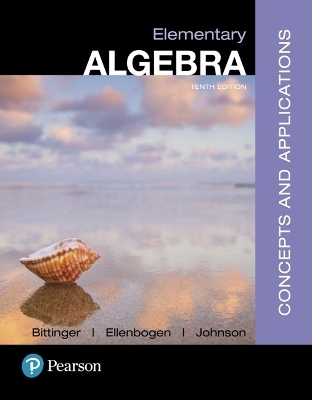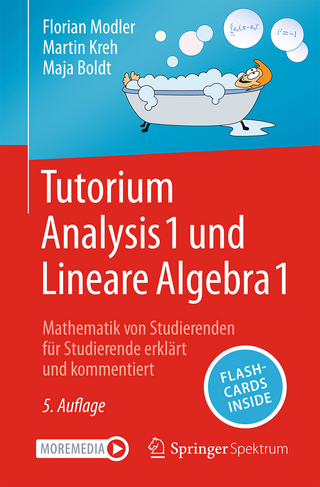
Elementary Algebra
Pearson (Verlag)
978-0-13-444137-5 (ISBN)
Understanding and Applying Mathematical Concepts
The goal of the Bittinger Concepts and Applications Series is to help today’s student learn and retain mathematical concepts. This proven program prepares students for the transition from skills-oriented elementary algebra courses to more concept-oriented college-level mathematics courses. This requires the development of critical-thinking skills: to reason mathematically, to communicate mathematically, and to identify and solve mathematical problems. The new editions support students with a tightly integrated MyLabTM Math course; a strong focus on problem-solving, applications, and concepts, and the robust MyMathGuide workbook and objective-based video program. In addition, new material – developed as a result of the authors’ experience in the classroom, as well as from insights from faculty and students – includes more systematic review and preparation for practice, as well as stronger focus on real-world applications.
Also available with MyLab Math.
MyLabTM Math is an online homework, tutorial, and assessment program designed to work with this text to engage students and improve results. Within its structured environment, students practice what they learn, test their understanding, and pursue a personalized study plan that helps them absorb course material and understand difficult concepts.
Note: You are purchasing a standalone product; MyLab does not come packaged with this content. Students, if interested in purchasing this title with MyLab, ask your instructor for the correct package ISBN and Course ID. Instructors, contact your Pearson representative for more information.
If you would like to purchase both the physical text and MyLab, search for:
0134772385 / 9780134772387 Elementary Algebra: Concepts & Applications Plus MyLab Math -- Title-Specific Access Card Package, 10/e
Package consists of:
0134441370 / 9780134441375 Elementary Algebra: Concepts & Applications
0134753879 / 9780134753874 MyLab Math with Pearson eText -- Standalone Access Card -- for Elementary Algebra: Concepts & Applications
Barbara Johnson has a BS in mathematics from Bob Jones University and a MS in mathematics from Clemson University, and she is currently pursuing a PhD in Educational Studies at Ball state University. She has taught high school and college math for 30 years, and she enjoys the challenge of helping each student grow in appreciation for and understanding of mathematics. As a Purdue Master Gardener, she also enjoys helping others learn gardening skills. Believing that the best teacher is always learning, she is also a student of karate. Marvin Bittinger has taught math at the university level for more than thirty-eight years, and he is now professor emeritus of mathematics education at Indiana University-Purdue University. Professor Bittinger has authored numerous textbooks on topics ranging from basic mathematics to algebra and trigonometry to applied calculus. He received his BA in mathematics from Manchester College and his PhD in mathematics education from Purdue University. Special honors include Distinguished Visiting Professor at the United States Air Force Academy. His hobbies include hiking in Utah, baseball, golf, and bowling. Professor Bittinger has also had the privilege of speaking at many mathematics conventions, most recently giving a lecture entitled "Baseball and Mathematics." In addition, he also has an interest in philosophy and theology, in particular, apologetics. Professor Bittinger currently lives in Carmel, Indiana with his wife Elaine. He has two grown and married sons, Lowell and Chris, and four granddaughters. David Ellenbogen has taught math at the college level for nearly 30 years, spending most of that time in the Massachusetts and Vermont community college systems, where he has served on both curriculum and developmental math committees. He has taught at St. Michael's College and The University of Vermont. Professor Ellenbogen has been active in the American Mathematical Association of Two Year Colleges (AMATYC) since 1985, having served on its Developmental Mathematics Committee and as a delegate. He has been a member of the Mathematical Association of America (MAA) since 1979. He has authored dozens of texts on topics ranging from prealgebra to calculus and has delivered lectures on the use of language in mathematics. Professor Ellenbogen received his bachelor's degree in mathematics from Bates College and his master’s degree in community college mathematics education from The University of Massachusetts–Amherst. In his spare time, he enjoys playing piano, biking, hiking, skiing, and volunteer work. He currently serves on the boards of the Vermont Sierra Club and the Vermont Bicycle Pedestrian Coalition. He has two sons, Monroe and Zachary.
Table of Contents
Introduction to Algebraic Expressions
1.1 Introduction to Algebra
1.2 The Commutative, Associative, and Distributive Laws
1.3 Fraction Notation
1.4 Positive and Negative Real Numbers
1.5 Addition of Real Numbers
1.6 Subtraction of Real Numbers
1.7 Multiplication and Division of Real Numbers
1.8 Exponential Notation and Order of Operations
Equations, Inequalities, and Problem Solving
2.1 Solving Equations
2.2 Using the Principles Together
2.3 Formulas
2.4 Applications with Percent
2.5 Problem Solving
2.6 Solving Inequalities
2.7 Solving Applications with Inequalities
Introduction to Graphing
3.1 Reading Graphs, Plotting Points, and Scaling Graphs
3.2 Graphing Linear Equations
3.3 Graphing and Intercepts
3.4 Rates
3.5 Slope
3.6 Slope-Intercept Form
3.7 Point-Slope Form
Polynomials
4.1 Exponents and Their Properties
4.2 Polynomials
4.3 Addition and Subtraction of Polynomials
4.4 Multiplication of Polynomials
4.5 Special Products
4.6 Polynomials in Several Variables
4.7 Division of Polynomials
4.8 Negative Exponents and Scientific Notation
Polynomials and Factoring
5.1 Introduction to Factoring
5.2 Factoring Trinomials of the Type x2 + bx + c
5.3 Factoring Trinomials of the Type ax2 + bx + c
5.4 Factoring Perfect-Square Trinomials and Difference of Squares
5.5 Factoring: A General Strategy
5.6 Solving Quadratic Equations by Factoring
5.7 Solving Applications
Rational Expressions and Equations
6.1 Rational Expressions
6.2 Multiplication and Division
6.3 Addition, Subtraction, and Least Common Denominators
6.4 Addition and Subtraction with Unlike Denominators
6.5 Complex Rational Expressions
6.6 Rational Equations
6.7 Applications Using Rational Equations and Proportions
Systems and More Graphing
7.1 Systems of Equations and Graphing
7.2 Systems of Equations and Substitution
7.3 Systems of Equations and Elimination
7.4 More Applications Using Systems
7.5 Linear Inequalities in Two Variables
7.6 Systems of Linear Inequalities
7.7 Direct Variation and Inverse Variation
Radical Expressions and Equations
8.1 Introduction to Square Roots and Radical Expressions
8.2 Multiplying and Simplifying Radical Expressions
8.3 Quotients Involving Square Roots
8.4 Radical Expressions with Several Terms
8.5 Radical Equations
8.6 Applications Using Right Triangles
8.7 Higher Roots and Rational Exponents
Quadratic Equations
9.1 Solving Quadratic Equations: The Principle of Square Roots
9.2 Solving Quadratic Equations: Completing the Square
9.3 The Quadratic Formula and Applications
9.4 Formulas
9.5 Complex Numbers as Solutions of Quadratic Equations
9.6 Graphs of Quadratic Functions
9.7 Functions
Appendix A. Factoring Sums or Differences of Cubes Appendix B. Mean, Median, and Mode Appendix C. Sets
| Erscheinungsdatum | 01.03.2017 |
|---|---|
| Sprache | englisch |
| Maße | 224 x 274 mm |
| Gewicht | 1506 g |
| Themenwelt | Mathematik / Informatik ► Mathematik ► Algebra |
| ISBN-10 | 0-13-444137-0 / 0134441370 |
| ISBN-13 | 978-0-13-444137-5 / 9780134441375 |
| Zustand | Neuware |
| Informationen gemäß Produktsicherheitsverordnung (GPSR) | |
| Haben Sie eine Frage zum Produkt? |
aus dem Bereich


